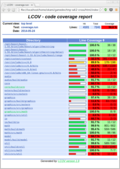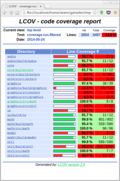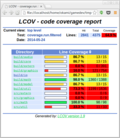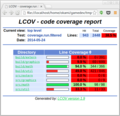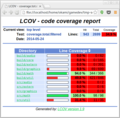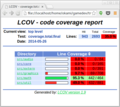Line coverage report using
gcov /lcov
When using unit-tests to add robustness to development projects, it is nice (even important) to be able to see which parts of your code is actually being tested.
If you are using
This creates a
The key is that when a program built with
This scribble is divided into three parts:
1. A general outline of the steps to create a clean coverage
report, which should apply to any
2. How I arrived at these steps (cheating a bit for brevity)
3. Finally I'll summarize the working script, an implementation of
the general outline.
1. General outline
- Clean project completely (you want a complete rebuild)
- Recompile everything with
gcov compile and link flags. - Use
lcov to process initial.gcno files. - Run all tests.
- Use
lcov to process.gcna coverage files. - Merge the initial and final
lcov files (step 3 andstep 5 ). - Filter
lcov output to only include project files. - Filter
lcov output to exclude unit test files, andmain.cpp . - Generate
html coverage report from final filteredlcov output..
The point of
2. Trial and error
First, a quick note on my
This completely separates the
I should also mention that my
2.1 First attempt
Let's skip
The result is quite messy. For some reason, it includes coverage
on
2.2 Second attempt - Excluding external files
Let's clean this up with some filtering that only includes files in the project (Much better. It still incorrectly lists directories that don't
exist. Also, when browsing to the individual source files, it only shows
the error message
2.3 Third attempt - Specifying source directory
Turns out that
Almost there. Unit test files are still included in the coverage
report. Since these will always have
2.4 Fourth attempt - Excluding unit test files
Above we extracted our project files, now let's further
remove all
Only relevant data now. However, I know that there are several
files that are not tested at all, and don't show up. Even a whole
directory (
2.5 Fifth attempt - Including static .gcno files
This is where
Finally, it shows my hitherto sloppy test coverage in all earnestness.
2.6 Sixth (final) attempt - Merging folders
The
That's right, a simple search-and-replace does the trick!
3. Summary - final script
Note: As of

